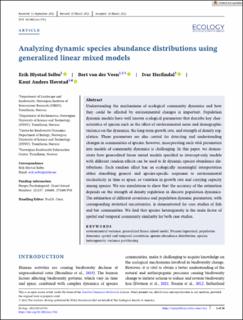| dc.contributor.author | Solbu, Erik Blystad | |
| dc.contributor.author | van der Veen, Bert | |
| dc.contributor.author | Herfindal, Ivar | |
| dc.contributor.author | Hovstad, Knut Anders | |
| dc.date.accessioned | 2022-10-07T12:44:26Z | |
| dc.date.available | 2022-10-07T12:44:26Z | |
| dc.date.created | 2022-05-18T11:25:35Z | |
| dc.date.issued | 2022-05-12 | |
| dc.identifier.citation | Ecology. 2022, 103 (9), . | en_US |
| dc.identifier.issn | 0012-9658 | |
| dc.identifier.uri | https://hdl.handle.net/11250/3024546 | |
| dc.description.abstract | Understanding the mechanisms of ecological community dynamics and how they could be affected by environmental changes is important. Population dynamic models have well known ecological parameters that describe key characteristics of species such as the effect of environmental noise and demographic variance on the dynamics, the long-term growth rate, and strength of density regulation. These parameters are also central for detecting and understanding changes in communities of species; however, incorporating such vital parameters into models of community dynamics is challenging. In this paper, we demonstrate how generalized linear mixed models specified as intercept-only models with different random effects can be used to fit dynamic species abundance distributions. Each random effect has an ecologically meaningful interpretation either describing general and species-specific responses to environmental stochasticity in time or space, or variation in growth rate and carrying capacity among species. We use simulations to show that the accuracy of the estimation depends on the strength of density regulation in discrete population dynamics. The estimation of different covariance and population dynamic parameters, with corresponding statistical uncertainties, is demonstrated for case studies of fish and bat communities. We find that species heterogeneity is the main factor of spatial and temporal community similarity for both case studies. | en_US |
| dc.description.abstract | Analyzing dynamic species abundance distributions using generalized linear mixed models | en_US |
| dc.language.iso | eng | en_US |
| dc.publisher | Wiley Periodicals LLC on behalf of The Ecological Society of America | en_US |
| dc.rights | Navngivelse 4.0 Internasjonal | * |
| dc.rights.uri | http://creativecommons.org/licenses/by/4.0/deed.no | * |
| dc.title | Analyzing dynamic species abundance distributions using generalized linear mixed models | en_US |
| dc.title.alternative | Analyzing dynamic species abundance distributions using generalized linear mixed models | en_US |
| dc.type | Peer reviewed | en_US |
| dc.type | Journal article | en_US |
| dc.description.version | publishedVersion | en_US |
| dc.rights.holder | © 2022 The Authors | en_US |
| dc.source.pagenumber | 14 | en_US |
| dc.source.volume | 103 | en_US |
| dc.source.journal | Ecology | en_US |
| dc.source.issue | 9 | en_US |
| dc.identifier.doi | 10.1002/ecy.3742 | |
| dc.identifier.cristin | 2025121 | |
| dc.relation.project | Norges forskningsråd: 244608 | en_US |
| dc.relation.project | Norges forskningsråd: 223257 | en_US |
| dc.relation.project | Norges forskningsråd: 272408 | en_US |
| dc.source.articlenumber | e3742 | en_US |
| cristin.ispublished | true | |
| cristin.fulltext | original | |
| cristin.qualitycode | 2 | |

